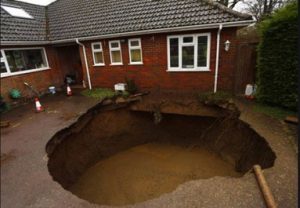What causes sinkholes?
Climate change has brought about a higher level of wet weather and the recent heavy rain and flooding increase the likelihood of sinkholes occurring across the UK.
But what are sinkholes?
Sinkholes, or Swallow Holes as they are also known, have become more common over the last few years with some 10,000 UK sinkholes listed on a British Geological Survey.
Sinkholes are usually created by the natural erosion or gradual removal of slightly soluble carbonate bedrock e.g. limestone or gypsum, by acidic rain percolating through and dissolving the bedrock or by the inward collapse of a cave roof.
Sinkholes are most common where the rock below the surface is limestone, Gypsum or other carbonate rock, or in other soluble rocks, such as sandstone or quartzite that can be dissolved naturally by circulating groundwater or acidic rain.
As the rock dissolves, spaces and caves develop underground. Groundwater may dissolve the carbonates that hold the sandstone particles together and then carry away the free particles, gradually forming a void. These sinkholes can be dramatic because the surface land usually stays intact until there is not enough support then a sudden collapse at the surface can occur sometimes without warning.
Prolonged flooding and wet weather will probably result in more sinkholes appearing over the coming months, as the main trigger for sinkholes is water saturating the ground. Heavy rainfall can speed up the creation of a sinkhole significantly. At least six are known to have formed over the past month, including a 5ft hole that appeared under a house in Ripon.
However, natural sinkholes depend on geology, as some rocks are more soluble than others. Limestone, chalk, gypsum and salt are particularly prone to this phenomenon which affects areas including parts of Yorkshire with Ripon and its environs being particularly susceptible, The Peak District, Dorset, Hampshire, The Chilterns and the “wich” towns of Cheshire.
What triggers a sinkhole?
Sinkholes can occur rapidly and without warning anywhere specific geological conditions exist, whether in the countryside, villages, modern housing estates or busy urban locations. Several processes can trigger sinkholes and while gradual erosion can cause a sinkhole to form at the surface, other factors including humans can exacerbate the problem.
Heavy rain or surface flooding can initiate the collapse of normally stable cavities, especially those developed or built over within superficial deposits such as gravel, clay or sand. Leaking drainage pipes, burst water mains, irrigation systems or even simply emptying a swimming pool are all known examples of sinkhole triggers.
Building works, construction and development are also potential triggers or simply altering surface water drainage. New developments will present an additional imposed loading to the land. Initial land drainage and subsequent surface water drainage systems installed play an important part in this respect. Past mining operations can also be a factor, either by draining or lowering of the water table, or by removal of clay voids which subsequently collapse. Sinkholes in Norwich have been caused by old chalk mines passing through otherwise stable sediment-filled voids. Likewise, periods of drought or groundwater abstraction can change the level of the water- table; removing the underground water support and draining the cavity can lead to collapse.
Sinkhole collapse can be very sudden, taking only a few seconds to a gradual inward slump over time. The rate of collapse depends on the surface material. While sand collapses gradually, clay may remain in place without any indication to suggest the catastrophic collapse that can occur without warning.
How to spot a sinkhole?
Anticipating the occurrence of a sinkhole collapse is not easy and there may be little surface evidence of its existence.
The primary indicator is location. Sinkholes predominantly occur in locations where specific geological conditions exist and so the likelihood can be reasonably anticipated in areas where there is a history of previous sinkholes in that region.
Clues to indicate the possible existence of a sinkhole includes:
- External depressions in the ground level particularly to the local roadway, or footpaths and driveways, patios etc.
- Slumped or leaning trees, telephone poles, fences or road signs also may help piece together evidence in this respect
- Any obvious structural movement both to the subject or properties in the locality may also be an indicator
- Internally, distorted openings and other signs of structural movement to doors and windows that may be stiff or out of square may not be an indicator in themselves but coupled with other evidence may help form an overall picture.
Where do sinkholes occur in the UK?
Most sinkholes are relatively small or are generally located in upland rural locations. They include areas underlain by Carboniferous limestone, notably the Mendips, parts of Wales, the Peak District, and the northern Pennines, including the Yorkshire Dales.
The most susceptible area in the UK is the Permian gypsum deposits of northeast England, particularly around Ripon and areas underlain by a similar geology. In Ripon, many large sinkholes have developed, some of which have affected property and local infrastructure. This is because gypsum is far more soluble than limestone and dissolves more rapidly. Sinkholes also occur over salt deposits, commonly in areas such as Cheshire where brine has been extracted making it difficult to separate naturally formed sinkholes from those created by man.
Chalk is also susceptible where it is covered by younger clay and sand deposits (the ‘Clay-with Flints’), notably in parts of Dorset, Hampshire and the Chilterns. Thurrock in Essex has also seen issues with sinkholes and due to past extraction and in the same location old mine workings by the Danes known as Dene holes have also caused problems.

If structural damage occurs because of a sinkhole, the building insurance may cover repairs under the standard subsidence provisions subject to any excess on the policy. Damage that occurs to the garden land however may not be covered and would depend on the terms of the policy. The British Geological Society provides advice for homeowners who may have an ongoing sinkhole affecting their property. Actions include cordoning off the area and advising the local authority and if necessary, arranging with service providers for appropriate disconnection e.g. gas, and electricity.
As surveyors, we should have a general awareness of the potential risk of a sinkhole occurring in a location by local knowledge built up through discussions with estate agents and vendors and local media. Local British Geological Survey maps may also provide an indication together with other published maps and other online data/media in this respect.
If the surveyor suspects a property may be at risk they should advise the legal adviser to obtain a local environmental search to highlight any known issues and also obtain specific information from the local authority building control to determine if there are known instances of sinkholes in the locality. In more pronounced cases further specific advice from an Engineer or other appropriate professional may be required. This would depend however on specific lender guidance on this matter.
Advice to homeowners might include actions to limit triggering processes checking/fixing leaks to the drainage systems or pipework and preventing the saturation of the local ground by collecting rainwater if soakaways are used. Garden watering using a hose could also be an issue in some instances.
From a valuation viewpoint, the surveyor should be aware of the potential for sinkholes in a locality and in order to determine whether the market has been impacted by the presence of a sinkhole/s may require additional research including a careful review of comparable evidence and perhaps discussions with local agents and other surveying colleagues.




